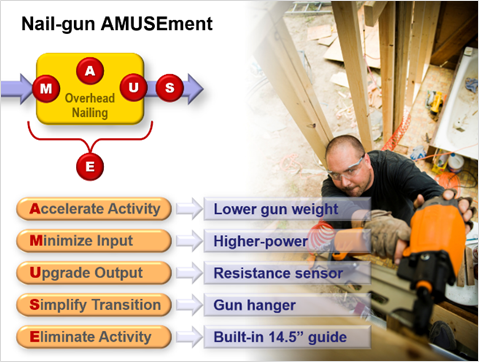You can employ Everyday VOC probing with customer tours... during the tour and afterwards
You can learn a great deal during a tour of your customer's facility... or observation of any customer process. Use your What-Why-Clarify probing to better understand customer needs both during and after your tour. (Caution: For safety reasons, get permission from your customer host before asking questions of workers while they are working.)
These tours present a good opportunity for you to discover possible ways to improve the customer's operation. Whether you mention your ideas now or save them for later, you can ask better probing questions if you have a framework for improving the customer's operation.
We developed the AMUSE customer tour methodology to help New Product Blueprinting practitioners with this. And this methodology will work well for any customer tours you may take.
Here's how it works. You break the customer’s operation down into a series of discrete activities… be it a manufacturing process, a field operation, or even a service. Then for each activity you ask:
- Could we Accelerate this activity?
- Could we Minimize the input to it?
- Could we Upgrade the activity output?
- Could we Simplify transitions to adjacent activities?
- Could we Eliminate the activity altogether?

Here’s an example: You manufacture nail guns and are observing the activity of overhead nailing by a house builder.
- Accelerate: If you lowered the weight of the gun, the operator would probably be moving faster by the end of his shift.
- Minimize: A higher-powered gun would penetrate tough knots, allowing the builder to use less expensive studs with knots.
- Upgrade: A resistance sensor would adjust the nail-driving power, avoiding exposed nails that must be finished with a hammer.
- Simplify: A gun hanger designed for 2x4 studs would let the operator avoid bending down to store his gun on the floor deck.
- Eliminate: A 14.5-inch guide would let the operator check the spacing between vertical studs, so he doesn’t have to pull out his tape measure.
Sure, these aren't all great ideas, but you probably get the idea: It helps to continually look for areas to improve. Someone once noted, "Discovery is seeing what everyone else has seen and thinking what no one else has thought."

To help with this, we created the Customer Observation Checklist, which is part of the SalesPrepTM system. This methodology is covered in more detail in SalesPrep e-learning module 9.
Keywords: customer tour, B2B customer tour, tour of customer facility, tour of customer operation, AMUSE, ethnography, ethnographic research, accelerate activity, minimize input, upgrade output, simplify transitions, eliminate activity, SalesPrep
